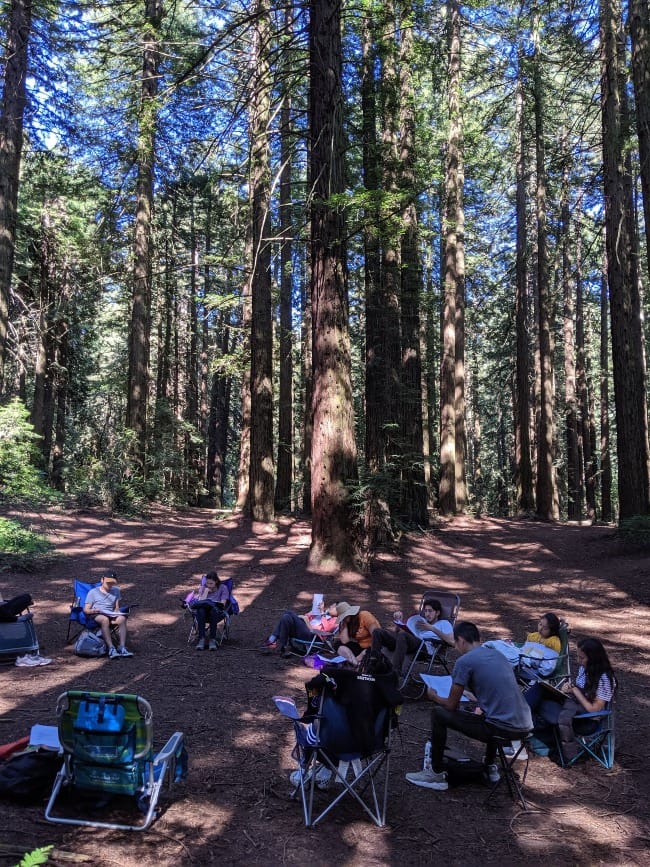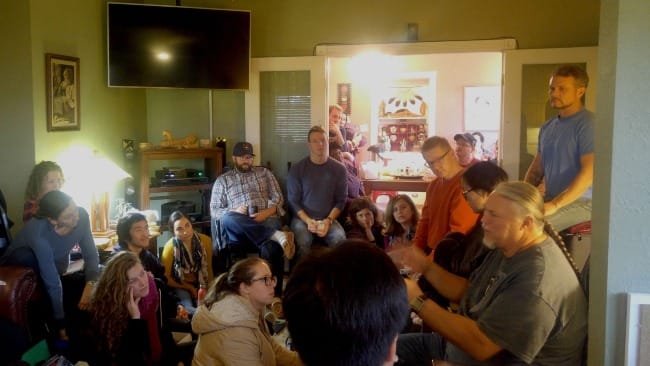Apocalyptic Sky
I awoke one mid-September morning to an eerie glow seeping in around the edges of our blackout curtains. Thinking it was the light of early dawn, I was glad to roll over and slide back into the liminal space between sleep and wakefulness for a little while longer. A quick glance at my phone revealed that it was, indeed, time for me to wake up. Why was it so dark?

A wildfire to the north of the Bay Area, combined with an inversion layer, was holding a thick blanket of smoke a few thousand feet above the ground. Though my air quality app showed only moderate levels of pollution at ground level, the sky remained an apocalyptic orange until late afternoon. In recent years we have seen increasing instances of smoky skies, even to the point of our kids having to stay home from school—while I have fond memories of snow days, my kids will look back on smoke days. However, this day felt different.
I curate and lead experiential discipleship programs for college students. I have been teaching about climate change and its impact on the planet for the past 16 years, and have a fairly good grasp on the science. These wildfires aren’t entirely caused by climate change. Fires have always been a part of ecosystems in the western United States, but 20 years of drought and record heat—coupled with a century of fire suppression policy—have created a scenario in which they burn hotter and faster than ever in recorded history.
That orange day shifted the awareness of climate disruption from knowledge in my head to a knowing deep in my bones. Looking at pictures, or simply recalling that day, fills me with a somber state of dread, coupled with a grounded sense of knowing. On that day I became clear that my learning journey is—and has always been—on two different, yet at times intertwining tracks. I understand my relationship to this planet both through my body and through my mind; sometimes, when I am stuck in one area, I can lean into the other to grow and transform.
Roots
I grew up in the East Weaver Creek watershed in Northern California. My parents moved to this rural area six months before I was born. We lived on two acres adjacent to a national forest, in a place where oak woodlands meet coniferous stands of Douglas fir and Ponderosa pine. My backyard was endless. The forest was my home. I recall spending entire afternoons climbing and simply sitting in trees, listening to the wind blow through the leaves. I loved to explore the seasonal creek that ran through our property, working my way up to its headwaters. One day, when I was seven and my sister was six, my father took us on a walk; we meandered along for about half a mile, up the hill behind our house. He then turned around and said, “Okay, now you two find your way back to the house.” No problem: we knew exactly how to get home. He was being a responsible parent, testing our knowledge of the area to make sure we wouldn’t get lost, and we passed with flying colors. Our home, along with summer camping trips, canoeing down the river, backpacking, hiking, and even hunting and fishing, all developed in us a deep love for and connection with nature.

Ours was a logging town. The local sawmill continues to be the largest employer in Trinity County. In the 1980s there was a fierce showdown between loggers and environmentalists, with death threats made by both sides. The conflict concerned clearcutting, a logging practice in which all the trees in a given tract are cut down, replanted, and sprayed with herbicide to kill the shrubs while allowing the young trees to survive. The Northern Spotted Owl is an indicator species in that ecosystem—its presence, or absence, represents the environmental health of the entire forest community. When the owl’s numbers declined, regulations changed and logging of local forests became more limited. The conversation in most of our town was that we had been forced to shut down our economy because of a “stupid bird.” Little concern was expressed about the health of the forest. At my church it was no different. I don’t recall ever hearing a sermon about our responsibility to care for creation. However, though an earth ethic wasn’t espoused in my faith community, my intuition and lived experience told me it was important.

Theology of the Land
When designing experiential discipleship programs for college students, I discovered the writings of Norman Wirzba, a professor at Duke Divinity School. In 2014, I invited him to speak to a small group of students as we set out to learn more about theology and ecology, soil and spirituality, on what we call an EcoPlunge. From his front porch in North Carolina, via Skype, he taught us about the doctrine of creation, that the good news of Jesus Christ is good news for the whole of creation (Col. 1:23). He showed us that the way of Jesus is experienced through the work of feeding people, healing people, and reconciling people, as Christ gives us a vision of a world that is ultimately reconciled. To live in a reconciled way is to live in such a way that our presence is good news to every other thing that we encounter. When God sees the world, He sees His love made visible, tactile, audible—and delectable. The character of the world is God’s love made material. If this is our operating assumption, how can we attack or degrade the world? This teaching nourished my soul, and my mind began to catch up to what my body already knew.

The Harmony Way
Another pivotal learning moment came when our team of experiential discipleship leaders spent several days in Oregon learning from Randy and Edith Woodley, the cocreators and sustainers of Eloheh: An Indigenous Center for Earth Justice. They graciously revealed to us the limitations of a Western worldview, and invited us to humbly learn about what Randy calls the Harmony way. Randy developed this concept by recognizing that his own Cherokee language and culture held an idea that resonated with the full definition of the Hebrew word Shalom—the value of right relationship with the Creator, oneself, other people, and the land. He studied more than 40 other indigenous languages and found that they all had a similar concept. Upon first meeting the Woodleys, they invited all 25 of us into their living room; we took up every available square foot of couch and floor. He asked each of us to share our name, where we were from, and what we were bringing into the learning time. We talked for nearly 3 hours, with some folks sharing—through tears—the incredible weights they were bearing. As the time-oriented leader in me kept thinking about the lectures and lessons we were not going to have time for if we kept this up, I nearly missed the important lesson unfolding right before me. People matter. Relationships matter. How could we truly know this if we didn’t experience it as a community?
My journey of Ecological Discipleship involves my whole self. It is built on the foundation of a love for and deep connection to the created world and has been nurtured along by wise and thoughtful teachers. It is a dance between the ever-evolving ideas in my mind and the intuitive curiosities that come from spending afternoons lying on the forest floor, listening to the trees.
Josh Harper
